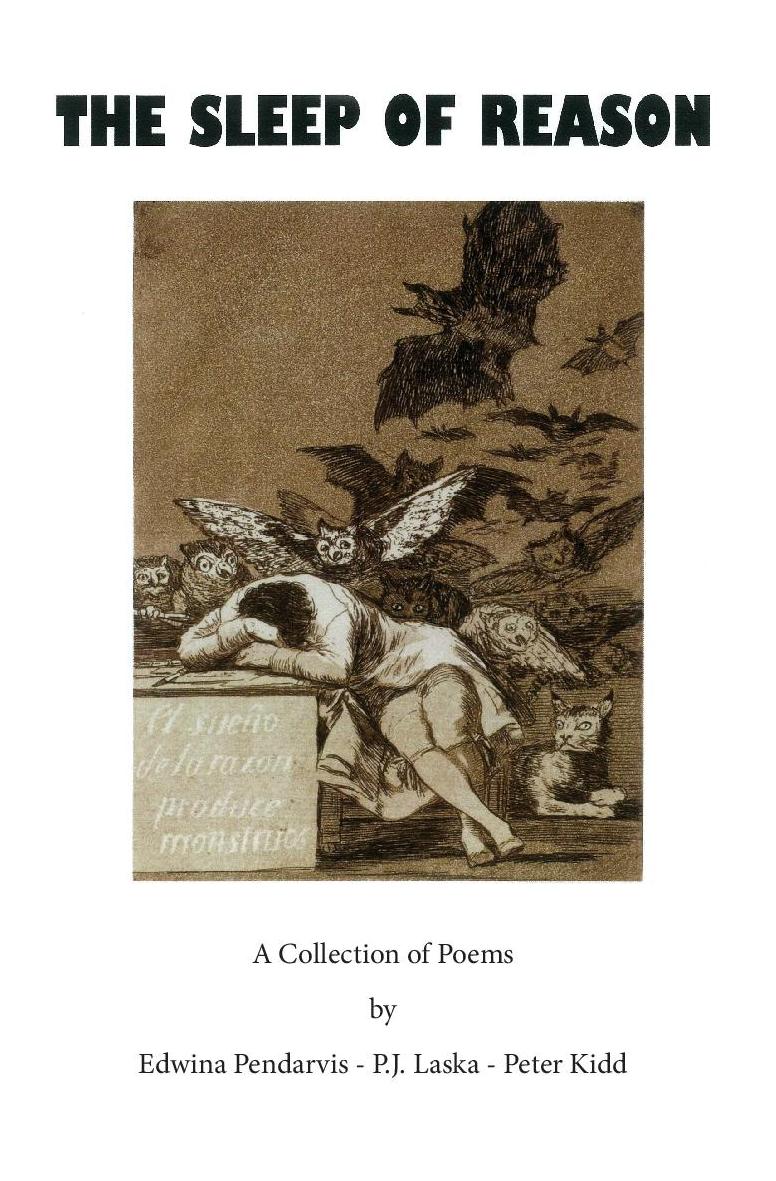
Words as Art in the Absence of Reason
A Review by: Phyllis Wilson Moore
In a rather Kafkaesque collection entitled The Sleep of Reason: A Collection of Poems by Edwina Pendarvis, P. J. Laska, and Peter Kidd, three seasoned activists, steeped in art, philosophy, history, and literature, provide an incisive glimpse at the state of the world and the political brouhaha and chaos we inflict upon ourselves.
The collection’s cover art, The Sleep of Reason Produces Monstrosities, by Francisco Goya, published in 1799, sets the stage for the words and images in the three sections of the chapbook. The title and the art serve to remind readers to consider world history.
Why Goya? Goya lived and painted during the last years of the Spanish Inquisition, a tumultuous period of war and corruption. He attempted to show the horrors of the day through art. Goya was labeled demented by Adolf Hitler.
Pendarvis builds on the Goya image by opening the chapbook with “Green Dreams”, a poem harking back to the Inquisition and the screams of martyrs, bloodied and broken on the rack, all in the name of religion.
Throughout, Pendarvis uses images of fire, bones, blood, cruelty, war, martyrdom, religiosity, and pollution, setting poems in the past and present. Her short poem, “Creche”, reminds readers of the January 17,1991, bombing of Baghdad. Aptly, Pendarvis compares the lighted sky above the city to a Christmas tree and the resulting death and destruction as the “gift” given the children of Baghdad.
She brings the sleep of reason closer home in “Farmer Brown Ascends the Gallows” as she reminds us of our nation’s history of slavery, the hanging of John Brown in Harpers Ferry, (now) West Virginia, and the subsequent Civil War. She calls Brown a planter of seeds and tells us his plants blossomed fire. The reason he was hanged? Treason. Many consider him a hero and martyr.
Pendarvis’s eight poems are followed by seven from P. J. Laska His first,“The Fall of America,” is a tribute to the work of the late poet Allen Ginsberg and Ginsberg’s collection, The Fall of America: Poems of these States 1965-1971, which shared the National Book Award for 1973. Like Ginsberg, Laska rails against the obvious destruction and contamination of the environment. He bemoans mountaintop removal in his native West Virginia, the waste clogged oceans, the struggling small towns.
He follows “The Fall of America” with a list poem,“The Greats”, a strong indictment of those using power for personal gain. Laska’s list includes “greats” readers will recognize from the daily news. Some of the greats may even produce a wry smile, perhaps “The Great Tweet” and the “Not-So-Great Offspring”. If reason sleeps, what is deemed great?
In his poem “Imagine Klee” Laska looks at Nazi Germany and Hitler’s confiscation and display of the paintings of artist he personally deemed mentally deficient or mentally ill. The crazed Hitler’s list included Klee, Picasso, and many others. Laska does not name Goya, but his work was included.
Peter Kidd’s section opens with the poem “2035”, a time when all water must be purified and the world we know no longer exists: shore lines are eroded, the climate is fierce, plants and trees are sparse. It reads like scary science fiction.
In his poems, Kidd details the impact of civilization’s “progress” and cites such particulars as the harm to dolphins off the coast of Hong Kong, the deforestation of the land, climate change, and the pollution of the ocean. He imagines the world his grandchildren will inherit.
Kidd adds some humor with “Autumn Afternoon Reflections”. He reflects on aloneness and aging: …”and now here I am/family grown and left/the dog has died/my mojo circle has shrunk/to my living room.” Despite the shrinking of his circle, his oneness with nature is illustrated in amusing conceits: damsel flies land on me/ the deer wink as they eat my grapes/ and the skunk waddles into my woodshed when I open the door.”
Kidd closes the collection with “Faults Shifted”, a poem with an optimistic core. His message: reason can be awakened and concepts can “get flipped” when reason is evoked.
The SLEEP OF REASON is word-art by three master poets. I feel sure Hitler would label them demented. I encourage you to consider their words.
The Sleep of Reason: A Collection of Poems by Edwina Pendarvis, P. J. Laska, and Peter Kidd, Igneus Press, 2019, $5


 Photo: Sarah Stone
Photo: Sarah Stone









